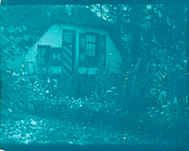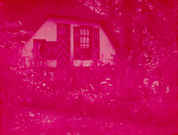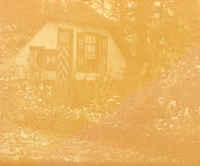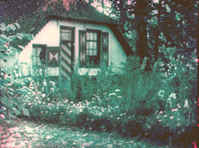| Photographic
Inheritance
Together with
the other activities, Klaver has also made many photo's and experimented
with camera's and techniques. His photographic inheritance, in the collection
of the printroom
of the University of Leiden, dept. Study and Documentation Centre for Photography,
contains four self made camera's and fourtynine small, thirtynine medium
and twelve large photographs. The majority of the photo's are printed on
developing paper, also some “broomolie” (bromide-oil) -prints, “gom” (gum)
-prints and colorprints. His main photography subjects were: trees, flowers,
chicken, a farmer with a bull, moors, countryroads and clouds above a village.
Probably he used these photographs as examples for his paintings. There
are resemblances. A clear example is a painting of a large Pine-tree (in
the property of granddaughter Ineke Klaver), for which Klaver has used
a photograph as an example. (Fig.1 and 2)
Inventor The photographic activities of Klaver are probably
motivated by a need for exposures for his own use. Once busy with photography,
he saw certain shortcomings in the coloremulsions and he searched for many
years after better solutions with respect to the "gekleurde beeld"(colored
image). With this term he tried to express his annoyance about the results
of the color photography techniques used at his time.
Strip Emulsions on Paper The innovations about which Klaver reported to
Boer concerned the stripping of emulsions from their respective carrier
(often paper or glass). According to Boer the major contribution of Klaver
consisted of the use of soft gelatin, contrary to the commonly used stripping
papers, with which the emulsion was prepared with a solution to make it
hard. Klaver prepared his developingpaper first with a thin layer of casein
and covered it with the lightsensitive emulsion layer. The exposed emulsion
could be taken of easily and mounted on a new carrier. With this method
of Klaver the technique of using strip emulsions got a wider application
for reproduction; for example putting art photographs on special paper
and for color photography. Klaver was especially interested in this last
aspect: putting together the three basic colors on glass became a lot easier.
In this report Klaver described both his new method of preparing a strip emulsion layer and his innovation concerning dichroic color filters with high reflectivity. The report has been given in Klaverís own handwriting: Undersigned declares to have found a method of generating : 1. Lightsensitive photographic material suited for both exposures and positive prints with a highly transparent emulsion which could be easily stripped. Contrary with comparable existing materials, it has been the goal to equalize the light absorbing aspects of both the carrier and the emulsion. This results in a flat product regardless of dry or wet conditions. The temporary carrier is a thin and very liquid absorbing paper with a very fine and homogeneous structure, which is prepared with a suited colloid.The ease of stripping the emulsion and the need of a high reflectivity of the temporary carrier has been obtained by moisting the paper and then powdering with: a) talcum powder, b) a solution of ox-gall, or c) another suited preparation. Immediately after, while being wet, the paper can be given a high reflectivity by for example a process of satinization. After drying the aforementioned prepared carrier, first a layer of gelatin is installed [according to Jan van Dijk, photographer and authority concerning historical photographic techniques, Klaver was talking now about his casein layer invention] and afterward the lightsensitive emulsionlayer.The second topic in Klavers report concerns the innovation of a color filter system: 2. Color filters of which the reflectivity is enhanced by the use of a very thin layer of certain dyes in certain solutions. The reflected lightbeam has the complementary color of the absorbing beam. Contrary with the disadvantages concerning transparancy of the well known technique of applying a thin layer of silver, the transparancy of the new filters has not been influenced badly. Color filter system and Camera design In his report in Focus, Adriaan Boer paid
attention to the application of this colorfilter system and furthermore
wrote that Klaver was also busy with a very ingenious camera for color
photography, and he had also a design for a device for cinematography in
natural colors. Klaver applied his invention of dichroic colorfilters in
his cameras for color photography. In cameras for three color photography
the photographic image has been obtained in one exposure through colorfilters
on three socalled subnegatives. Klaverís filters are mounted in
the middle of the camera in a crosswise support.
At a certain moment, Klaver contacted the instrumentmaker L.Blok in Lisse. Blok made prototypes for him, and originally there was a very good cooperation. In Oktober 1935, Blok wrote an extensive proposal for a cooperation between Klaver as an inventor, Blok as a prototypebuilder, the Gevaert company in Antwerpen who was going to produce the stripping lightsensitive paper and the Kipp company in Delft who was going to built camera prototypes for photography and cimematography. Furthermore Blok mentioned the names of Prof. Ornstein, Gen. Maj. Van Albada and Dr. A.C.S. van Heel, who would support the project with advice and laboratory equipment. Blok also wrote that Klaver was going to earn fl.250,- per month in this project and he finished the proposal with: "In total you can count on an amount of fl.20000,- needed for the finalization. Not requested immediately ofcourse and probably only partially needed". The correspondence between Klaver and Blok shows that their critical view with respect to the practical realization of the project decreases during the thirties. Blok makes Klaver believe that the project could be realized and slightly manipulates him to continue. However, Klaver's enthousiasm decreases, because he gets in larger financial problems, also because he, by recommandation of Blok, has borrowed substantial amounts of money for the project. The concept of Klaver's colour-filter The practical appearance of Klaver's experiments
with his selfmade camera and color filter system, is illustrated by some
conserved examples in the collection of the Printroom of Leiden University.
Except some color prints on paper (fig. 6 a through d) there is also a
9 x12 cm box for glasnegatives with Klaver's handwriting: "Exposures threecolorcamera"which
contains exposed glasplates positives with color emulsions which certainly
are made with Klaver's camera .
The yellow image (c) is slightly orange. Klaver had not mounted his yellow image (c) in the composite (d). We added this with the computer. (click d to look at the larger image). The three original black and white subnegatives, which where originally exposed, were not found in his inheritance. The three colored glasplates are obtained after contact printing with the black and white negatives. After the study of the previously described color exposures, the German photohistorians and color photography experts Gert Koshofer, Klaus Hübner and Gerhard Bersick arrived at the following conclusions: Klaverís colorfilter divides the incoming light in the three basic colors red, green and blue. Fig. 9 shows how the yellow (G) and the purple (P) filter divides the light from the objective (L) into the three basic colors. For the preparation of the three colored glassplates, Klaver has very probably used one of the following two possibilities: 1) the colordye was applied later in the emulsion on the glass, 2) the glass positives did already have the proper colordye pigment layer: after the exposure the unexposed material has been deleted by flushing with water (“Auswaschrelief”, as described by Koshofer 1981 Volume III fig. 76). In this period, glasspositives with the proper dye-gelatin layer, suited for the “Auswaschrelief” process, could easily be obtained for all kind of three color processes. Very thin filters Klaver continued with his search for filters with
improved absorption and reflection characteristics. He wrote in a document
(stored in the printroom): "I succeeded producing very thin filters with
a thickness of 1/100 - 2/100 mm, and I also improved the reflection characteristics".
He also wrote that it was better not to document his procedures in a patent,
but to consider this as a factory secret. This argument together with his
financial problems,
Pioneer? Was Klaver a Pioneer? We tried to judge that from
the study of competing patents with which he had to deal. His patent proposals
K119741 and K126933 were not accepted because the patent office found to
many similarities with a French patent from 1911 (patent 433187) and two
German patents from 1913 and 1927 (patents 274582 and 526309). Patent 274582
from 1913 is originally obtained by the Britisch inventor Eyre Coote Townsend
from Brighton and contains already two crossing dichroic filters as utilised
by Klaver. Townsend has used correction lenses in front of the film planes
in order to correct the optical errors caused by the filters though which
the light passes under 45 degrees.
Financial miscalculation Finally his invested money appeared to have been spent without profits. For years he paid his instrumentmaker L.Blok. The costly patent procedures and the annual payments te extend the patents, brought him into big financial problems. Regularly he had to delay payments, the rent of 't Oude Spyker was often paid late and there are no indications of profits from the patents. Regardless his good ideas and large investments, Klaver's inventions did not give him fame. He was overtaken by the producers of the Gasparcolor process (1933), the Kodachrome process (1935) and the Agfacolor process (1936). These techniques, without the use of filters, which were very intensely used after the war, did neglect Klaverís innovations, because of their more constant quality and very quick working speed. Significance Luite Klaver had many innovative ideas as a nursery man, photographer and inventor, but he lacked commercial insight and knowledge of men. Because of the lack of these talents, many fascinating experiments and innovations failed as commercial applications. Besides of the fact that his daughter Clare characterized him as an “anti-social phantast” , it is still justified to save him from oblivion in the history of photography, because of his brilliant analysis of several problems in the colorphotography technique. His promising innovations were at his time respected by scientists and engineers in Holland, Belgium (Gevaert) and England (Ilford), which appears from letters in the inheritance of Klaver. But his solutions were hardly suited for series production. |
|||||||||||||
|
back to first part of Luite Klaver's biography back to Luite Klaver'sindex page |
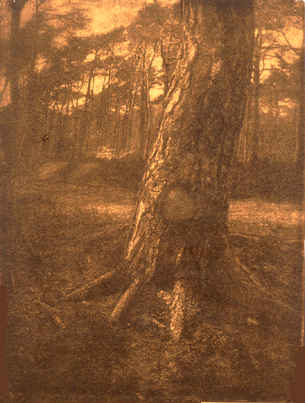
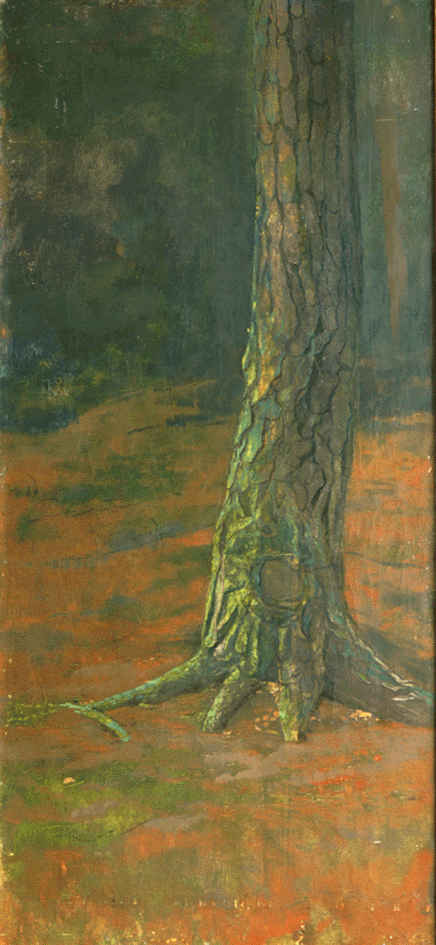
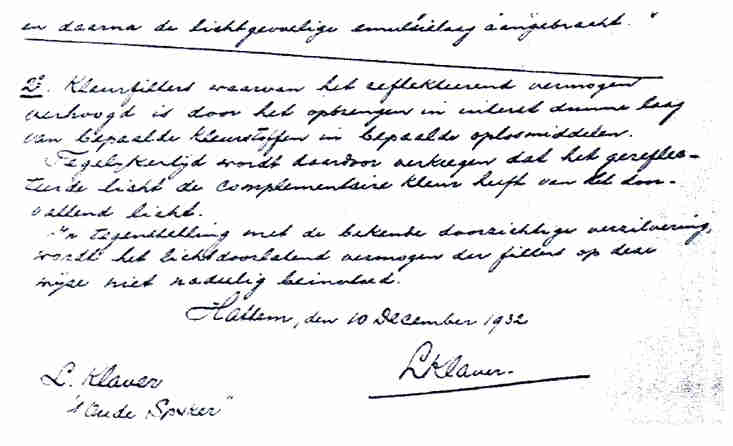
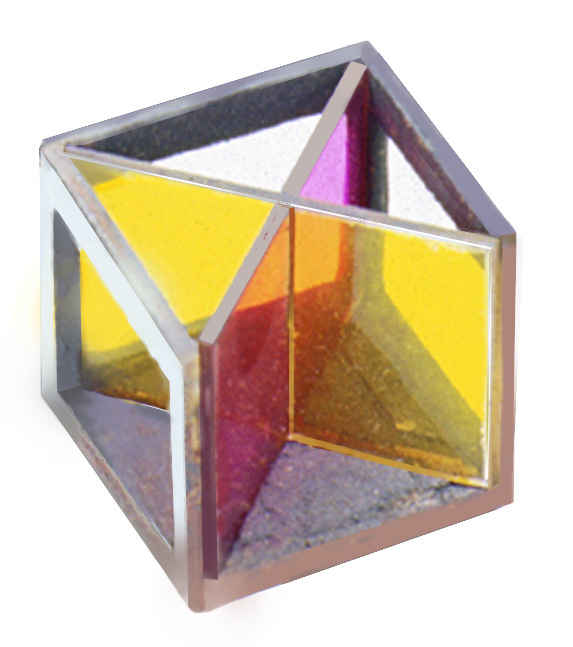
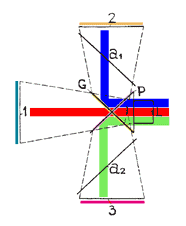
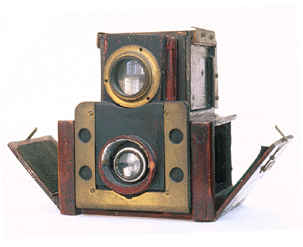 fig.6
Luite Klaver's original camera
fig.6
Luite Klaver's original camera
